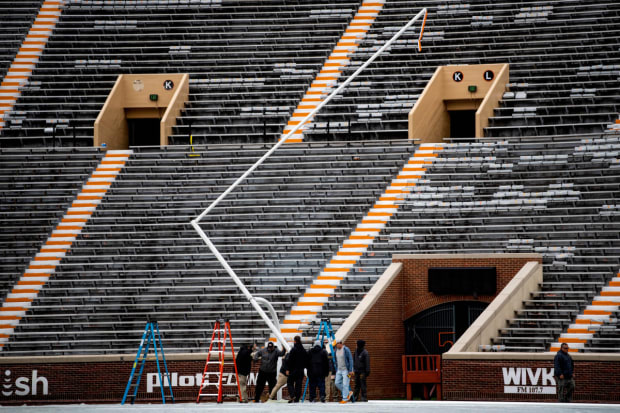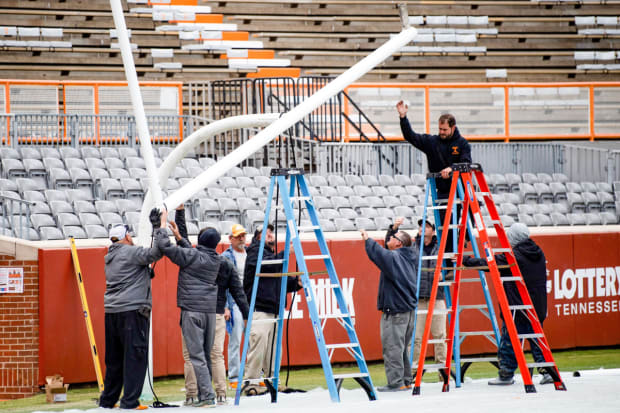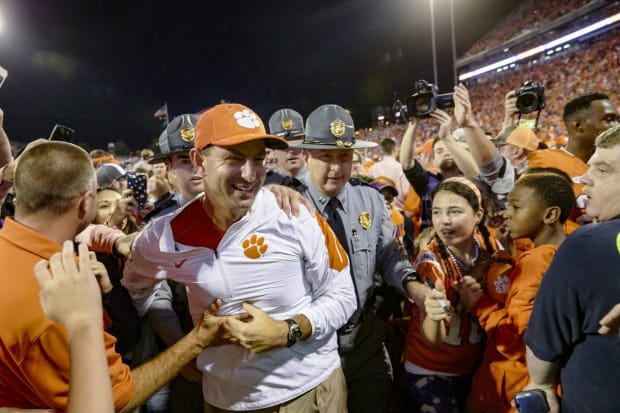As Kendre Miller plunged into the end zone to help TCU earn an overtime victory against Oklahoma State last Saturday, thousands of jubilant fans decided to join him. They hopped over railings in cowboy boots and sundresses, sneakers and flip-flops, making an approximate 7-foot drop onto the Amon G. Carter Stadium field.
One fan took his shirt off almost immediately to reveal a perfect Texan farmer’s tan. Another pounded his chest as he ran downfield as if he was the one who just scored. Quarterback Max Duggan, who handed off the ball to Miller, didn’t break stride as a fan put his arm around him for an impromptu selfie. ESPN’s skycam settled around midfield as the team’s mascot was hoisted in the air by two cheerleaders in chorus to DJ Khaled’s “All I Do Is Win.”
Minutes later inside a jubilant locker room, Horned Frogs coach Sonny Dykes returned to address his team after making it through a claustrophobic on-field postgame interview. But there was one problem: a significant portion of players hadn’t made it inside yet. Some were still stuck outside celebrating in a scene all too familiar in college football: a field storming.
They’re almost a weekly occurrence these days, but in three of Week 7’s biggest games, we saw close games with tight results become the impetus for what is “a pitch invasion” called across the pond. TCU pulled off a 14-point comeback, as did Utah around 12 a.m. ET. But the capital of the college football universe saw a field storming 15 years in the making in Knoxville, Tenn.
There, the goalposts also came crashing down in a scene reminiscent of 1998, when the Vols beat Florida en route to a national championship. But when the party’s over, when Dykes and his team are finally in the locker room, when the goalposts in Knoxville are being marched outside of Neyland Stadium and thrown into the Tennessee River, someone has to clean up.
That’s where folks like Andrew Siegel, TCU’s sports turf manager, come in. Siegel dealt with a similar scenario earlier in the season after the Frogs blew out Oklahoma. In the Oklahoma State game, when the Frogs started mounting their comeback, a field storm was brewing.
“Once it looked like that was an option, I was like, ‘Oh, they’re not keeping anybody off this thing,’” Seigel says. “But I definitely have a lot easier job than [my counterpart at Tennessee] does going forward, because it looked a little rough from the pictures I saw after that. Our fans were a little more cordial than they were up there in Knoxville, to say the least.”
The timing of this field rush wasn’t exactly the best for Siegel and his staff. Mid-October is the time when the grounds crew puts down rye grass seeds on top of the existing Bermuda lawn in a process called overseeding. It doesn’t take much to bring Bermuda grass back even after it’s compacted. But during the Oklahoma State game, the rye seed had been down for just about a week.
After waiting for fans and equipment to be cleared from the field, Siegel and his eight-person crew get to work. Before they can do normal postgame field upkeep, they have to clean up the debris so their five mowers (which cost $80,000 to $100,000) can get to work without damaging the blades and avoiding costly repairs. They strap up with backpack leaf blowers and metal detectors to make sure they get everything.
“The first thing we immediately have to do is start cleaning it, because you never really know what you’re going to find,” Siegel says. “I think we found cellphones, which we got back to their owners, because it’s the end of the world when you lose your cellphone. We’ve also picked up sunglasses, a pocketknife, lighters, peanuts, pizza crust and beer cans.”
At least Siegel didn’t have to replace goalposts. A Tennessee athletics department spokesperson confirmed to Sports Illustrated that they had a set of stored and disassembled goalposts under their student section that had been in place since 1998—just in case. They cleaned and painted them within 48 hours and erected them a day later, even after the school launched a “goalpost fund” to raise money for replacements. (Brand-new uprights cost between $10,000 and $20,000, according to the Knoxville News Sentinel.) The SEC also fines every school $100,000 for field storming in an attempt to discourage the practice.

Brianna Paciorka/News Sentinel/USA TODAY Network

Brianna Paciorka/News Sentinel/USA TODAY Network
As for the stolen sod, the spokesperson said the Neyland Stadium grounds crew maintains extra emergency-use sod just in case. By this past Wednesday, it would be “fairly hard to tell that Saturday’s postgame celebration ever took place.”
Siegel and his staff were able to do the majority of the heavy lifting to fix their field. They added some extra seed and put a layer of fertilizer down Saturday night, which they usually wouldn’t do. On Monday, they also put down between 10 and 15 tons of sand and aerated the field to help it recover. Another thing speeding up their process—TCU has a game this Saturday (as does Tennessee). Both of those surfaces are natural grass, whereas Utah’s is artificial. The Utah athletic department did not respond to requests for comment about their postgame cleanup.
Siegel says he expects it to be good to go when the Frogs host West Virginia.
Fans, meanwhile, seemingly ignore the road team during on-field celebrations, but you never know what can happen when thousands of people are within that emotional groundswell.
Case in point: Texas A&M’s upset of Alabama last season at Kyle Field.
Watch college football with fuboTV. Start your free trial today.
“It was probably the week before [that] game when we had an internal operations meeting with our game event staff and myself and my boss at the time, and university police to just discuss, not specifically if we beat Alabama but in the event that the fans chose to storm the field,” says Nick McKenna, Texas A&M’s assistant athletic director for sports fields. “‘What are our protocols? What’s our approach? What’s our operations? How do we handle it? Where do we focus security staff? What’s our exit strategy for getting people back off the field?’”
Halfway through the fourth quarter, before the Aggies won on Seth Small’s buzzer-beating kick, McKenna began communicating with his staff about the possibility of fans storming the field. He wanted his staff to make sure they were out of chaos’s way as much as possible and assigned every staff member a piece of equipment, like a pylon or a goalpost cover, that could become keepsakes by a fan with sticky fingers. They also made sure there were folks to keep tabs on Bama’s sideline.

David E. Klutho/Sports Illustrated
A&M has hydraulic goalposts that can drop within 30 seconds after the press of a button, but the school had actually removed and stored the hydraulic cylinders to protect them from the elements throughout the year. Instead, they opted to station state troopers at the base of the posts as a deterrent. Tearing the goalposts down can look like fun, but it’s not exactly safe when the posts snap, and a 10-foot-high crossbar and 40-foot-high uprights drop with a significant amount of force.
It’s also not exactly safe for players trying to get off the field as the fans rush on. Alabama wide receiver Jermaine Burton was caught on video apparently striking a woman while exiting the field. Saban said his team is looking into the incident and will handle discipline internally. Texas Tech was fined $50,000 when a fan shoved a Texas player while rushing the field earlier this season, while a BYU fan broke his leg during last year’s Holy War while rushing the field.
“People aren’t paying attention to what’s happening or coming at them as they’re so caught up in the moment that they just charge out onto the field with no awareness of what’s happening around them,” McKenna says. “This Alabama state trooper and our university police officer were actually jogging Coach Saban off of the field and a girl hopped down on the field, stopped right in front of him and our university police officer actually trucked her over. Not maliciously. It literally happened that quick. She stopped directly in front of him. He had a fraction of a second. Coach Saban almost tripped over her as she was laying on the ground.”
Field storming is a chaotic and indelible part of college sports. It is mostly all in celebration, but if thousands of people decide in a tidal wave of emotion that they’re coming out on the field, there isn’t much anyone can do despite P.A. announcements, police marching onto the field or event staff trying to cordon off postgame handshakes with ropes. Despite the work involved in the aftermath, some involved in the cleanup don’t mind too much.
“Twenty years ago when I started in this industry, the young, go-getter field manager in me got annoyed by it,” McKenna says. “It is some of what makes college athletics great. Now, is it something I want every week? Is it ideal? No. But, at the same time, you embrace it. You can’t change it. You know what, go out and enjoy yourselves. Have fun. We’ll do our job and do everything to cover it and make the field right afterward.”







